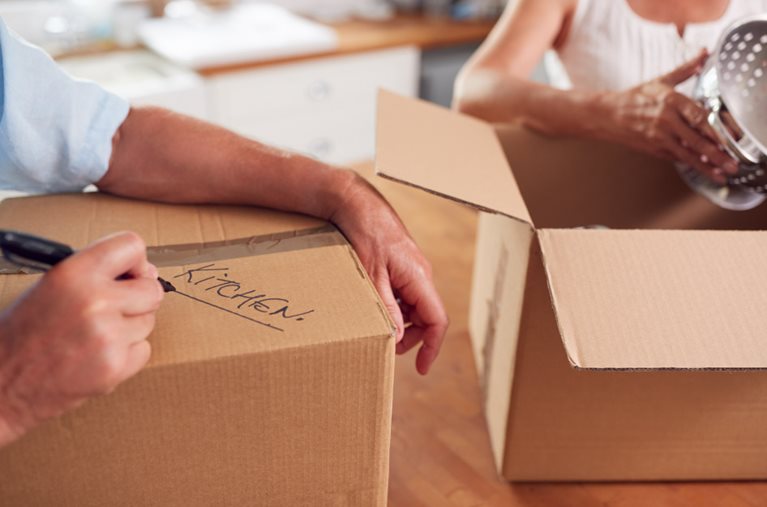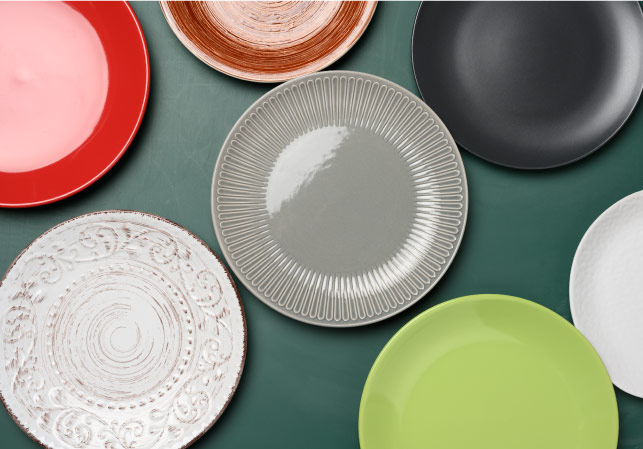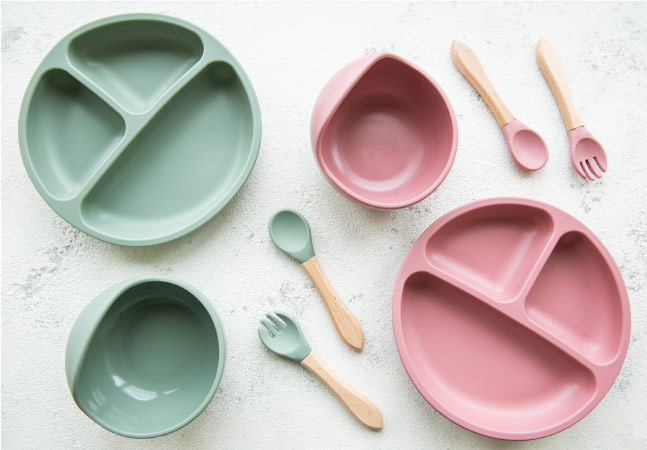
How To Pack Dishes for Moving — and Ensure Your Other Kitchen Items Are Protected, Too
Moving Tips and Hacks
So you're busy sorting through all of your possessions ahead of your upcoming move — and then it hits you: You’re not quite sure how to pack dishes for moving. How much cushioning do you need? And what kind of cushioning should you use? It’s one of the most challenging parts of a move. Regardless of the distance, if your delicate dishes aren’t packed correctly, that could be a recipe for disaster.
First things first: You should begin the process of packing dishes by decluttering the items you no longer want. Not only will you free up space, but you’ll also know you’re not taking more than you need. You can donate your unwanted items to a reputable organization or even to family and friends.
Then you should get the proper supplies. Doing so will protect your expensive and fragile items from damage during transit. One thing to keep in mind? Weight. As tempting as it may be to try to fit all of your dishes in one large box, that’s a big no-no. The larger and heavier the box, the more likely the contents will inevitably get damaged (think: the bottom falls apart as you’re carrying it). Small or medium-sized boxes are the way to go. Even better, if you can get your hands on some double-walled boxes that are made specifically for dishes, you’ll be golden. Because they have that additional layer of cardboard, they’re sturdier than traditional moving boxes.
Essential Packing Supplies for Moving Dishes
- Boxes (Preferably Double-Walled)
- Packing Tape
- Cushioning (Bubble Cushioning Roll, Packing Paper, Towels, Etc.)
- Scissors
- Permanent Markers
How To Pack Dishes for Moving — FAQs
Q: What is the best way to pack dishes for moving?
A: It’s best to wrap fragile items in bubble cushioning roll. Other supplies such as packing paper can provide additional support. However, packing paper alone is typically more suitable for items that are not at risk of breaking.
Q: Should you pack dishes vertically or horizontally?
A: It’s best to wrap all of your dishes and then pack them vertically, as they are less likely to break that way.
Q: How to pack dishes for moving without paper?
A: Packing paper alone is typically more suitable for items that are not at risk of breaking. Bubble cushioning roll and towels are sturdy and supportive alternatives to paper when it comes to packing dishes — especially fragile ones.
Q: How do I pack kitchenware for moving?
A: The process of packing kitchenware to move involves ensuring the dishes are wrapped properly, secured in the moving boxes, and transported with the utmost care. Want to know specifics? Keep reading!

If you have a lot of fragile dishes, you may want to use bubble cushioning roll to protect them during your move
How To Pack Plates for Moving
When considering how to pack plates, specifically, packing paper may come to mind. After all, it’s an economical material that can be used to wrap up a variety of items as you prepare for your move. However, if you have a lot of fragile dishes, you may want to use an alternative product. Bubble cushioning roll is our go-to for items that can easily be broken.
Before you start adding any plates to a moving box, make sure there is a layer of cushioning at the bottom. You can use various materials such as bubble cushioning roll, towels, or packing paper (but plenty of it) to protect your dishes from bumps that may occur while traveling in the moving vehicle.
Then wrap and secure each plate with plenty of material — whether that’s bubble cushioning roll, paper, or something else. Repeat until all of the items are wrapped, and place the plates vertically inside the boxes. When a box is full, fill in any gaps with additional cushioning (it doesn’t have to be the same material; whatever fits), and put a layer of cushioning on top, to prevent the dishes from moving and to provide all-around protection.
Finally, make sure each box is marked as fragile on all sides to ensure careful handling!
How To Pack Bowls for Moving
First, make sure the bottom of each moving box is covered with your chosen material, just like you did with the plates. Then place one bowl at a time in the center of a large piece (or pieces) of your cushioning.

Wrap each of your glasses or cups individually to ensure they stay safe while traveling.
How To Pack Glasses for Moving
Like bowls, you’ll want to take extra care when wrapping your breakable glassware. Wrap each of your glasses or cups individually to ensure they stay safe while traveling, and avoid nesting the cups together, if you think their stability may be compromised. Then put the heaviest and bulkiest items on the bottom. As you know, putting down thick towels or packing material first and last will help protect each box's top and bottom. And you’ll definitely want to make sure to indicate these boxes are fragile.
How To Pack Wine Glasses for Moving
For delicate stemware, you’ll want to double wrap each piece and place them in the top half of the boxes. Start by wrapping the actual stems separately, for added protection. Then move on to the glasses, as a whole. Be sure to layer packing material inside the cup portions and around the items to ensure a snug fit in the boxes.
How To Pack Mugs for Moving
Although mugs are typically less fragile than wine glasses, they do have handles that could easily break off during transit, if you’re not careful. You can still use methods previously discussed; you’ll just want to put extra focus on filling in the gaps between the mugs when they’re placed inside the boxes.
| Did you know? Just as there are dish-specific packing boxes, there are drinkware-specific boxes. These come with dividers, making it easy and convenient to pack all of your glasses! |
How To Pack Utensils for Moving
Want to know the ultimate hack when it comes to how to pack utensils? Bundle your silverware and other small tools together in groups, tape them up with painters tape, and simply keep them in their organizers. You can just wrap the trays in some of your cushioning that you’re using for other dishware, and place them in moving boxes lined with padding — just like the rest of your dishes.

Package sharp knives extra carefully to ensure none of your other belongings get punctured during your move!
How To Pack Sharp Knives for Moving
Okay, okay. Packing knives isn’t so simple. It’s very important to package sharp items such as knives extra carefully before a move to ensure none of your other belongings get punctured!
You can still bundle them together; you’ll just need to wrap each one individually — and in extra-thick cushioning — before you do that. You also need to ensure everything is securely taped. You definitely don’t want any knives sliding out of their packaging! Our suggestion? Wrap all of the knives individually in several sheets of packing paper, and then wrap bundles of wrapped knives in bubble cushioning roll.
How To Pack China for Moving
Sure, in the perfect world, you would have the original packaging for each of your pieces in your china collection. But that’s just not reality. You know what is real? The sentimental value — and very likely the monetary value. So you want to take extra care of these pieces.
Treat them like you’re treating everything else, but add additional layers of protection. For example, consider wrapping pieces with something soft, like cloths, then several sheets of packing paper, and then a layer of bubble cushioning roll. Overboard? That depends on how special the pieces are to you.
How To Pack Pots and Pans for Moving
Heavy metal cooking equipment such as pots and pans should be wrapped in packing paper and placed at the bottom of boxes to prevent damage to other items. Before you start packing other items, though, put some additional packing paper on top of the pots and pans for padding.
If it won’t damage your cookware, nest your pots and pans together with padding between the pieces to save space. You can secure your lids separately. If they are glass lids, wrap them individually, like you did your plates, for added protection throughout the moving process.
After the boxes have been packed, make sure they have all the necessary labels. If a box is heavy, for example, you should label it as such — just like you did with your fragile boxes.
| Pro Tip: Wondering how to pack casserole dishes for moving? Use the same process that you use for bowls. Just try to group the items by size and shape, to make the most of your space. And be extra mindful of the weight of your boxes. That weight can definitely add up quickly with casserole dishes! |

Baby items are typically durable and won’t need to be individually wrapped before packing.
How To Pack Baby Supplies for Moving
If you have a large collection of baby items, such as bottles, plates, and sippy cups, it’s a good idea to keep them all in the same box when moving, so you easily have all of the items in one place. The moving process can be even more stressful when an entire family is involved, especially with a baby. Packing all of your baby items in one place will save you time and tears!PODS Helps You Move Efficiently — In More Ways Than One
PODS does more than simply deliver portable moving containers conveniently to your driveway. You can also order your packing supplies from PODS Boxes and have them delivered right to your door (with fast, free delivery!). That’s one more thing you can check off your list! And if you decide you need help packing up your kitchen, PODS can refer you to local packing and loading services, too.
Related Articles
Comments
Leave a Comment
Your email address will not be published. Required fields are marked *
